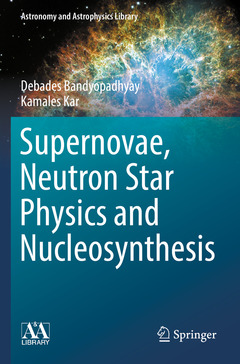Description
Supernovae, Neutron Star Physics and Nucleosynthesis, 1st ed. 2022
Astronomy and Astrophysics Library Series
Authors: Bandyopadhyay Debades, Kar Kamales
Language: English
Subject for Supernovae, Neutron Star Physics and Nucleosynthesis:
73.84 €
In Print (Delivery period: 15 days).
Add to cartPublication date: 03-2023
207 p. · 15.5x23.5 cm · Paperback
116.04 €
In Print (Delivery period: 15 days).
Add to cartPublication date: 03-2022
207 p. · 15.5x23.5 cm · Hardback
Description
/li>Contents
/li>Biography
/li>Comment
/li>
1. INTRODUCTION
2. THEORY OF SUPERNOVA EXPLOSIONS
2.1 Overview- historical
2.2 Supernova Type Ia
2.3 Gravitational collapse and pre-supernova conditions2.4 Production of neutrinos and their emission
2.5 Shock wave formation and its eventual stalling
2.6 The revival of the shock wave- the neutrino mechanism
2.7 Multi-dimensional hydrodynamic simulations and the present scenario
2.8 The supernova SN1987A
2.9 Detection of neutrinos from future supernova events
3. NEUTRON STARS
3.1 History and discovery of neutron stars
3.2 Observational Constraints on neutron stars
3.3 Compositions and novel phases of neutron stars - crust to core
3.4 Equation of State (EoS) models of neutron star matter
3.5 Relativistic field theoretical models for dense matter at zero and finite temperatures
3.6 Tolman-Oppenheimer-Volkoff Equation and Structures of neutron stars
3.7 A stable branch of compact stars beyond neutron star
3.8 Rotating neutron stars, moment of inertia (I) and quadrupole moment (Q)
3.9 Neutron star matter in strongly quantizing magnetic fields
3.10 EoS tables for supernova and binary neutron star merger simulations
4. BINARY NEUTRON STAR MERGERS
4.1 Gravitational waves as new window into neutron stars
4.2 First binary neutron star (BNS) merger GW170817 and multi-messenger astrophysics
4.3 Tidal deformability, LOVE number and EoS
4.4 I-Love-Q universal relations4.5 Late inspiral phase of BNS merger, tidal deformability and cold EoS
4.6 Neutron Star radius determination from tidal deformability
4.7 Hot and neutrino trapped merger remnant and finite temperature EoS
5. SYNTHESIS OF HEAVY ELEMENTS IN THE UNIVERSE
5.1 s-, r- and p-processes
5.2 Conditions for production of elements by r- process and the sites
5.3 Electromagnetic counterpart of GW170817 and ejected matter in BNS merger
5.4 Decompression of ejected neutron rich matter in Lattimer and Schramm model
5.5 Kilonova model
5.6 Heavy element synthesis in neutron rich matter ejected in GW170817
INDEX
BIBLIOGRAPHY (eventually at chapter-ends)Debades Bandyopadhyay is a former senior professor at the Astroparticle and Cosmology Division, Saha Institute of Nuclear Physics, Kolkata, India. He obtained his PhD degree from the University of Calcutta. He worked as a postdoctoral researcher at the Institute for Theoretical Physics, Frankfurt University, Germany. His areas of research include topics ranging from nuclei to neutron stars, and he is particularly involved in the study of dense matter in neutron star interiors. He was the recipient of the Alexander von Humboldt Fellowship, Germany. He is a regular visitor to the Frankfurt University and Frankfurt Institute for Advanced Studies (FIAS), Germany.
Kamales Kar is presently a visiting professor at the Ramakrishna Mission Vivekananda Educational and Research Institute, Belur Math, West Bengal, India. He retired from the Theory Division of Saha Institute of Nuclear Physics as a senior professor. He received his PhD degree from the University of Rochester, USA, working on problems related to nuclear structure. After postdoctoral positions at the University of Toronto, Canada, and Physical Research Laboratory, Ahmedabad, India, he joined the faculty of Saha Institute. He was a regular visitor to the University of Padova, Italy, and Complutense University of Madrid, Spain, for research collaborations. His research interests are in neutrino physics and astrophysics as well as in areas of nuclear astrophysics and nuclear structure.
Offers an updated overview on the current topical issues in nuclear astrophysics research
Presents the latest findings in supernovae physics, neutron stars and binary neutron star mergers
With a special focus on gravitational waves, neutrino astrophysics and pulsar physics




